Abstract
Infection of cell cultures with human rotavirus preparations was attempted and the effects of trypsin and low-speed centrifugation on antigen incorporation, as demonstrated by immunofluorescence and radioimmunoassay, were determined. In addition, the effect of viral aggregation on antigen incorporation was investigated by filtering viral preparations. Four strains of human rotavirus were employed, and the results were compared to those obtained with two tissue culture-adapted animal rotaviruses. Centrifugation and trypsin appeared to have little or no effect on infectivity of the tissue culture-adapted (simian rotavirus) or -adaptable (Nebraska calf diarrhea virus) strains, whereas centrifugation and viral aggregation appeared to be essential for the human viruses. In addition, trypsin enhanced antigen incorporation of the human strains to some extent. Infectivity for cell cultures and in vitro human rotavirus protein formation was demonstrated by [35S]methionine incorporation, and the specificity of this human viral protein was established by radio-immunoprecipitation.
Full text
PDF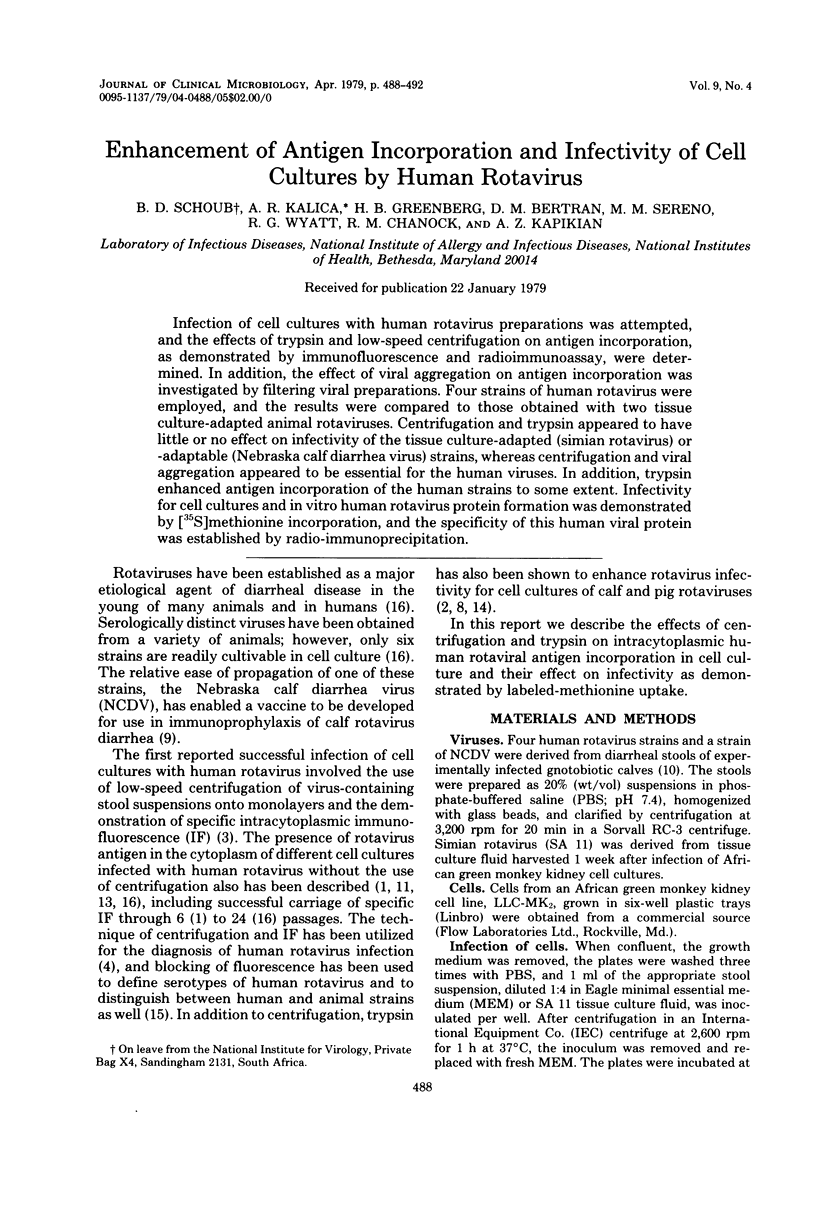
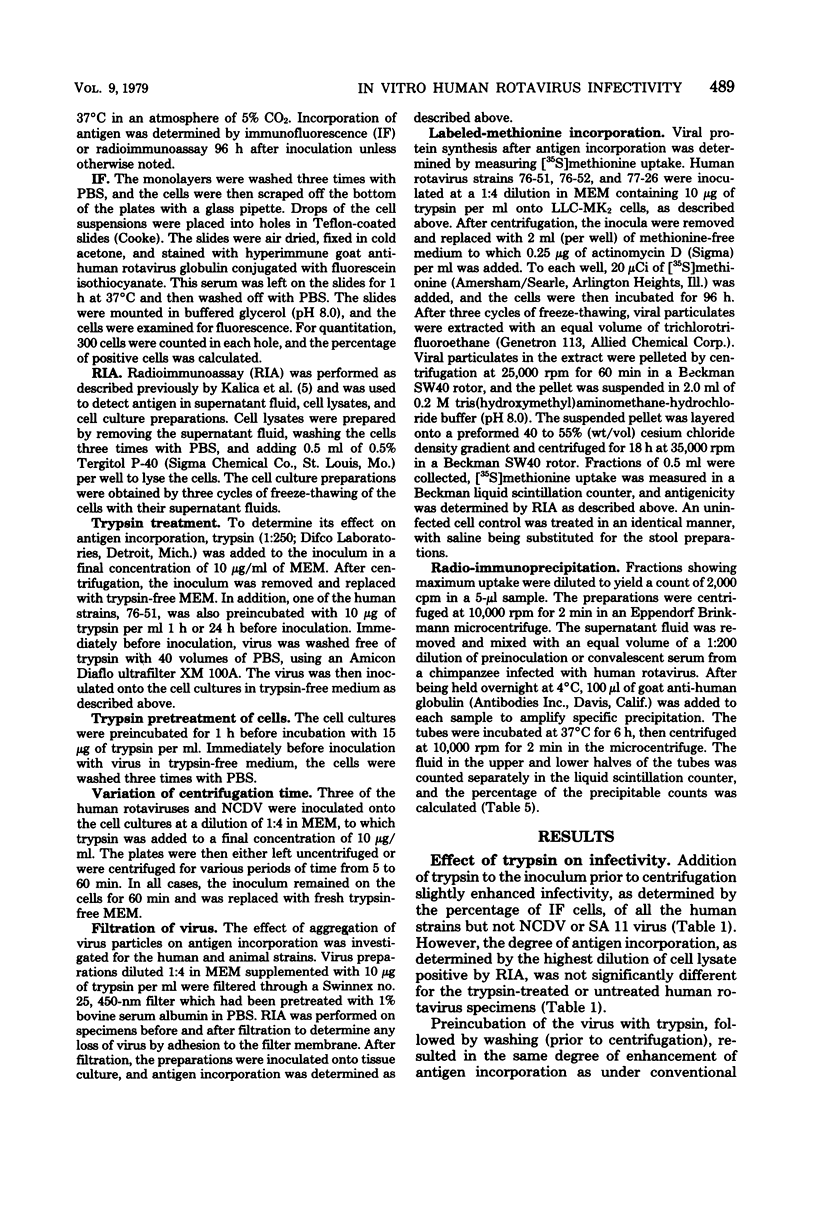
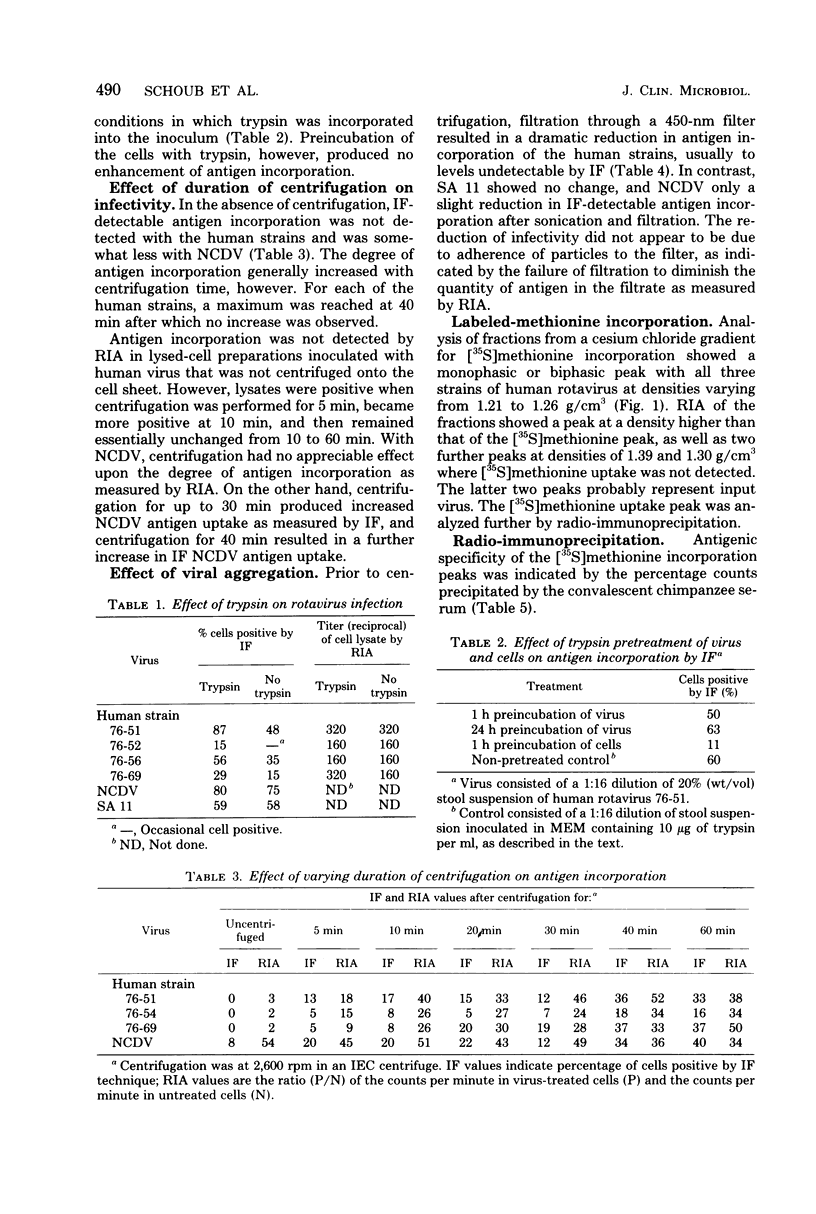
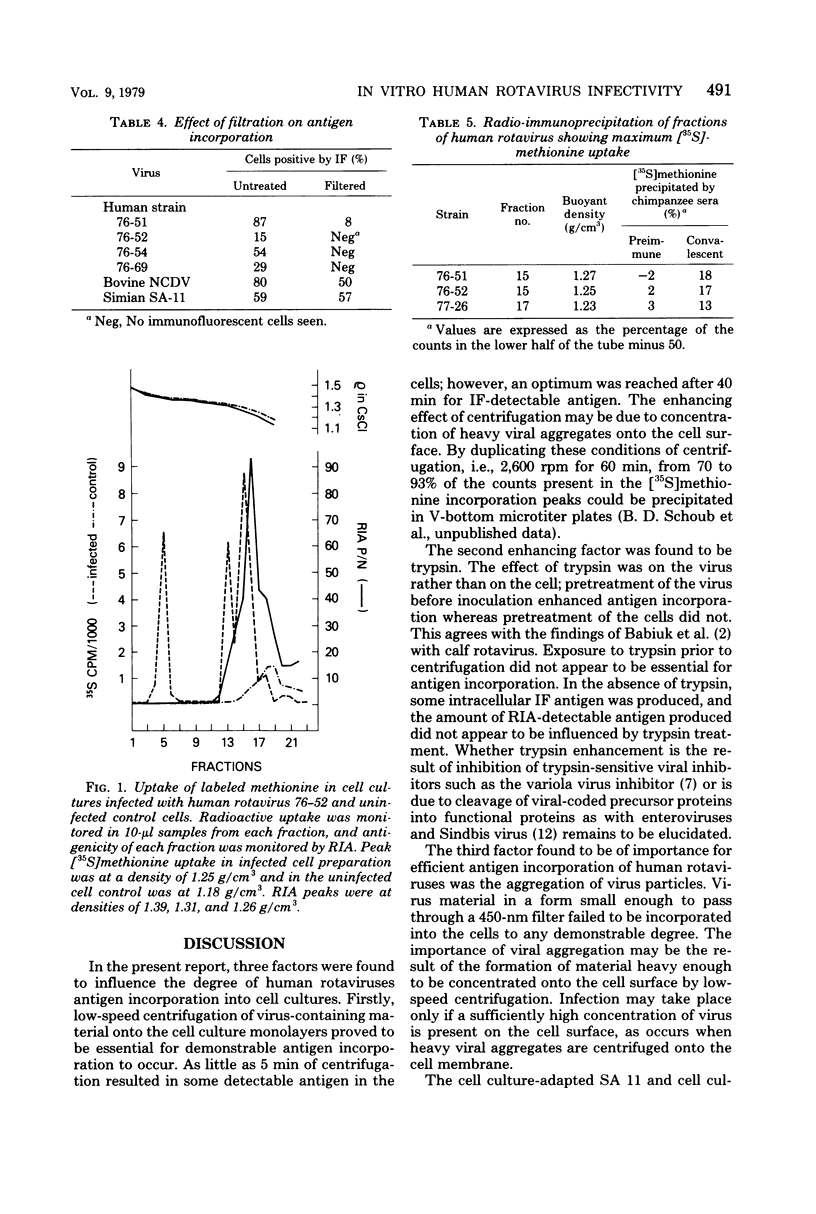
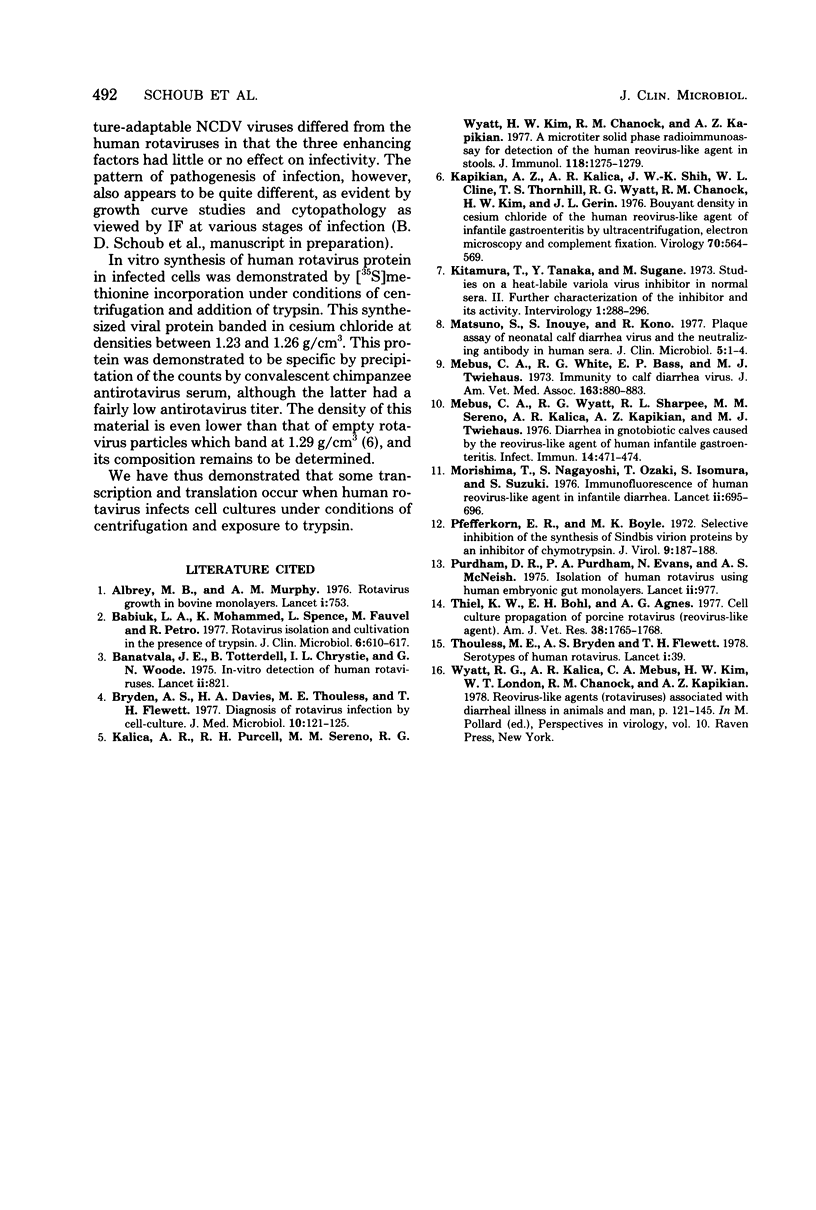
Selected References
These references are in PubMed. This may not be the complete list of references from this article.
- Albrey M. B., Murphy A. M. Letter: Rotavirus growth in bovine monolayers. Lancet. 1976 Apr 3;1(7962):753–753. doi: 10.1016/s0140-6736(76)93136-6. [DOI] [PubMed] [Google Scholar]
- Babiuk L. A., Mohammed K., Spence L., Fauvel M., Petro R. Rotavirus isolation and cultivation in the presence of trypsin. J Clin Microbiol. 1977 Dec;6(6):610–617. doi: 10.1128/jcm.6.6.610-617.1977. [DOI] [PMC free article] [PubMed] [Google Scholar]
- Banatvala J. E., Totterdell B., Chrystie I. L., Woode G. N. In-vitro detection of human rotaviruses. Lancet. 1975 Oct 25;2(7939):821–821. doi: 10.1016/s0140-6736(75)80057-2. [DOI] [PubMed] [Google Scholar]
- Bryden A. S., Davies H. A., Thouless M. E., Flewitt T. H. Diagnosis of rotavirus infection by cell culture. J Med Microbiol. 1977 Feb;10(1):121–125. doi: 10.1099/00222615-10-1-121. [DOI] [PubMed] [Google Scholar]
- Kalica A. R., Purcell R. H., Sereno M. M., Wyatt R. G., Kim H. W., Chanock R. M., Kapikian A. Z. A microtiter solid phase radioimmunoassay for detection of the human reovirus-like agent in stools. J Immunol. 1977 Apr;118(4):1275–1279. [PubMed] [Google Scholar]
- Kapikian A. Z., Kalica A. R., Shih J. W., Cline W. L., Thornhill T. S., Wyatt R. G., Chanock R. M., Kim H. W., Gerin J. L. Buoyant density in cesium chloride of the human reoviruslike agent of infantile gastroenteritis by ultracentrifugation, electron microscopy, and complement fixation. Virology. 1976 Apr;70(2):564–569. doi: 10.1016/0042-6822(76)90301-9. [DOI] [PubMed] [Google Scholar]
- Kitamura T., Tanaka Y., Sugané M. Studies on a heat-labile variola virus inhibitor in normal sera. II. Further characterization of the inhibitor and its activity. Intervirology. 1973;1(4):288–296. doi: 10.1159/000148857. [DOI] [PubMed] [Google Scholar]
- Matsuno S., Inouye S., Kono R. Plaque assay of neonatal calf diarrhea virus and the neutralizing antibody in human sera. J Clin Microbiol. 1977 Jan;5(1):1–4. doi: 10.1128/jcm.5.1.1-4.1977. [DOI] [PMC free article] [PubMed] [Google Scholar]
- Mebus C. A., Wyatt R. G., Sharpee R. L., Sereno M. M., Kalica A. R., Kapikian A. Z., Twiehaus M. J. Diarrhea in gnotobiotic calves caused by the reovirus-like agent of human infantile gastroenteritis. Infect Immun. 1976 Aug;14(2):471–474. doi: 10.1128/iai.14.2.471-474.1976. [DOI] [PMC free article] [PubMed] [Google Scholar]
- Morishima T., Nagayoshi S., Ozaki T., Isomura S., Suzuki S. Letter: Immunofluorescence of human reovirus-like agent of infantile diarrhoea. Lancet. 1976 Sep 25;2(7987):695–696. doi: 10.1016/s0140-6736(76)92517-4. [DOI] [PubMed] [Google Scholar]
- Pfefferkorn E. R., Boyle M. K. Selective inhibition of the synthesis of Sindbis virion proteins by an inhibitor of chymotrypsin. J Virol. 1972 Jan;9(1):187–188. doi: 10.1128/jvi.9.1.187-188.1972. [DOI] [PMC free article] [PubMed] [Google Scholar]
- Purdham D. R., Purdham P. A., Evans N., McNeish A. S. Letter: Isolation of human rotavirus using human embryonic gut monolayers. Lancet. 1975 Nov 15;2(7942):977–977. doi: 10.1016/s0140-6736(75)90386-4. [DOI] [PubMed] [Google Scholar]
- Theil K. W., Bohl E. H., Agnes A. G. Cell culture propagation of porcine rotavirus (reovirus-like agent). Am J Vet Res. 1977 Nov;38(11):1765–1768. [PubMed] [Google Scholar]
- Thouless M. E., Bryden A. S., Flewett T. H. Serotypes of human rotavirus. Lancet. 1978 Jan 7;1(8054):39–39. doi: 10.1016/s0140-6736(78)90381-1. [DOI] [PubMed] [Google Scholar]


